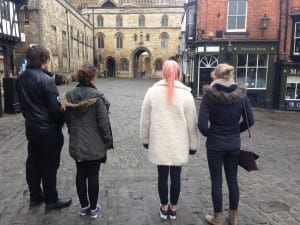After spending the weekend recording all our audio pieces (an example below is of the first audio piece), we decided to test out our working version of the performance within the site.
Although we had planned to walk around the site using the audio tour, we were met with several obstacles that prevented us from doing this fully. The area itself was very busy with a crowd of people outside to see the unveiling of the floral tribute to Operation Manna, which was placed near the beginning of our tour, whilst we were also unable to walk up the steps near the Tennyson statue due to it being repainted. As such, we could not truly listen to the audio, and had to pause it several times to walk around the area. However, this event did allow us to take several photos, as documented here, of moments happening within our site that would not have been there otherwise. Taken inspiration from Fortnight, which said to be “offering the opportunity to fit moments for art into everyday life…creating reasons to question and alter taken-for-granted ways of engaging with the city” (Hui, 2011, 17), we used such obstacles to our advantage to see our site in a new light through different people’s perspectives and uses.
Once Rachel had experienced our tour in its current version, she gave us several comments to use to improve our piece further in these last few weeks. We need to work on the length of pauses and the timings of our site overall, allowing our audience to wait and move around the site at a comfortable pace. We need to make sure our directions are clear to our audience, as at times it can be confusing. We need to work on the tone of the voice we use in the audio, making it seem as if we are a companion to the individual, to help build a relationship between the two. We need to use words like “I” and “we” to reflect our own thoughts and experiences, rather than asking reflective questions, as such a reflection should occur naturally. Overall, we need to make the audio more poetic and suggestive, keeping in mind words like “inviting”, “encouraging” and “generosity” as we move forward, as if there is the feeling, as Rachel put it, “we are holding their hand”.
Hui, Allison. (2011) Art as an everyday intervention: shifting times, places and mobilities in the pervasive media performance project “Fortnight”. Hong Kong: Hong Kong Baptist University.

